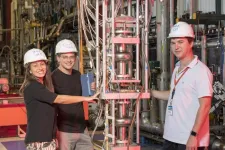(Press-News.org) ROCHESTER, Minn. — In a pilot study of 165 people, Mayo Clinic researchers looked at the effectiveness of two different approaches to weight loss: a standard lifestyle intervention and individualized therapy. The standard lifestyle intervention included a reduced diet, exercise and behavior therapy. The individualized approach was based on phenotypes and included different interventions depending on the person's predominant underlying cause of obesity. A diet based on phenotypes considers a person's genetic and phenotypic characteristics to create a tailored eating plan meant to optimize health and well-being.
The researchers compared whether diet and lifestyle interventions tailored to obesity phenotypes would work better than standard lifestyle interventions on weight loss, cardiometabolic risk factors and physical variables contributing to obesity. Cardiometabolic health describes the connection between the heart and blood vessels and the body's energy and chemical processes. It covers a wide range of disorders and risk factors that contribute to heart disease and metabolic syndrome.
In adults with obesity, the phenotype-tailored lifestyle interventions resulted in more weight loss than the standard lifestyle interventions of a reduced-calorie diet, exercise and behavior therapy.
Findings after 12 weeks included:
Patients who used phenotype-tailored lifestyle interventions did better in treating their obesity than those who used standard lifestyle interventions.
The phenotype-focused group of patients had more significant weight loss, reduced waist circumference, reduced triglycerides, reduced daily caloric intake and less anxiety.
They had a substantial increase in lean mass percentage.
They also had a lesser decrease in the number of calories required by the body during resting conditions.
"The results stress the relevance of identifying the underlying cause of obesity as a complex disease with many factors," says Andre Acosta, M.D., Ph.D., a Mayo Clinic obesity researcher and the study's last author.
What is a phenotype-tailored intervention?
Obesity phenotypes are based on the cause of the disease and behavioral components and include three main areas:
Homeostatic eating — eating in response to a perceived energy need by the brain.
Hedonic eating behavior — consuming foods for pleasure, not for physical hunger or energy needs.
Abnormal energy expenditure — the number of calories burned in 24 hours compared to an average person.
Four actionable phenotypes of these areas include abnormal fullness, measured by calories ingested to experiencing unpleasant fullness; abnormal duration of fullness; emotional eating behavior; and abnormal resting energy expenditure.
The researchers reported that people who used the phenotype-tailored lifestyle interventions showed significant improvement in some targeted areas, such as abnormal fullness and emotional eating.
"The results of this study support the need for an actionable, phenotype-based classification [of patients in obesity treatment] rather than relying only on the number on the scale, body measurements or [if they have] obesity-related diseases, such as heart disease, high blood pressure and certain cancers," says Dr. Acosta.
Opportunities for further research
Dr. Acosta says more research is needed to assess the long-term effect of a phenotype-based approach. In particular, further studies may need to look at other physical and metabolic variables to understand people with no identified phenotype.
Dr. Acosta also notes that the effects of therapy on the two approaches must be examined independently. People with an emotional eating component received a more intense intervention, with 24 behavior modification sessions, to address this underlying trait that may have a leading role in obesity development.
"More research will enhance the tailored approach proposed from the data," says Dr. Acosta. "We will continue to work on individualized obesity therapy directed at specific traits to identify the right therapy for the right patient."
Declaration of interests
Dr. Acosta is a stockholder in Gila Therapeutics and Phenomix Sciences; he was a consultant for Rhythm Pharmaceuticals, General Mills, Amgen, Bausch Health, and RareStone; has contracts with Vivus Inc, Satiogen Pharmaceutical, and Rhythm pharmaceutical; and has a patent submitted for biomarkers of a phenotype-tailored diet.
This article originally appeared on the blog of the Individualized Medicine blog.
###
About Mayo Clinic
Mayo Clinic is a nonprofit organization committed to innovation in clinical practice, education and research, and providing compassion, expertise and answers to everyone who needs healing. Visit the Mayo Clinic News Network for additional Mayo Clinic news.
END
Mayo Clinic researchers pave the way for individualized obesity therapy, tailoring interventions to a person’s needs
2023-07-21
ELSE PRESS RELEASES FROM THIS DATE:
Deep-dive into one state's telehealth use shows key trends and policy opportunities
2023-07-21
In just three years, millions of people across Michigan’s two huge peninsulas have taken advantage of their newfound ability to connect with their doctors, nurses and therapists through a computer or phone, a new report shows.
Between 11% and 17% of all appointments to evaluate symptoms or discuss treatment now take place virtually, depending on the type of insurance, the analysis shows.
That’s up from less than 1% of such visits before the COVID-19 pandemic suddenly spurred temporary flexibility in health insurance rules for telehealth, according to the report by a team from the University of Michigan Institute for Healthcare ...
Bodybuilding supplement may help stave off Alzheimer’s
2023-07-21
The secret to protecting your memory may be a staple of a bodybuilder’s diet. RUSH researchers recently discovered that a muscle-building supplement called beta-hydroxy beta-methylbutyrate, also called HMB, may help protect memory, reduce plaques and ultimately help prevent the progression of Alzheimer’s disease.
HMB is not a prescription drug or a steroid, but an over-the-counter supplement that is available in sports and fitness stores. Bodybuilders regularly use HMB to increase exercise-induced gains in muscle size and strength while improving exercise performance. HMB is considered safe even after long-term ...
IU team contributes six research papers to Human BioMolecular Atlas Program collection in Nature
2023-07-21
Katy Börner’s team from the Luddy School of Informatics, Computing, and Engineering’s Cyberinfrastructure for Network Science Center has made significant contributions to constructing a Human Reference Atlas and has led or co-authored six research articles in a just-released HuBMAP package in Nature.
Börner, Victor H. Yngve distinguished professor of engineering and information science, and CNS director, leads one of the two mapping components within the NIH-funded Human BioMolecular Atlas Program. Her team includes ...
Research supporting increased crop growth published in Proceedings of the National Academy of Sciences
2023-07-21
NORMAN, OKLA. – An article describing research conducted by John Peters, Ph.D., chair of the Department of Chemistry and Biochemistry, Dodge Family College of Arts and Sciences at the University of Oklahoma, and fellow researchers, has been published in the journal Proceedings of the National Academy of Sciences.
The article “Structural insights into redox signal transduction mechanisms in the control of nitrogen fixation by the NifLA system” explores the way bacteria regulate the expression of genes related to nitrogen fixation – the conversion of nitrogen in the air into ammonia that can help plants grow.
“Using small angle X-ray scattering ...
Fiber optic sensing tracks seismicity from injected carbon dioxide at Australian site
2023-07-21
Researchers at a field site in Victoria, Australia are among the first to use fiber optic distributed acoustic sensing (DAS) for high-precision tracking of induced seismicity from a small carbon dioxide (CO2) injection, according to a new study published in Seismological Research Letters.
The CO2CRC Otway Project in Victoria is a research test site for the subsurface storage of carbon dioxide, as one possible way to reduce the impacts of climate-warming carbon emissions. However, there is a risk of induced earthquakes after gigatons of carbon dioxide will be injected within the same geologic ...
Biosurfactants might offer an environmentally friendly solution for tackling oil spills
2023-07-21
Can biosurfactants increase microbiological oil degradation in North Sea seawater? An international research team from the universities of Stuttgart und Tübingen, together with the China West Normal University and the University of Georgia, have been exploring this question and the results have revealed the potential for a more effective and environmentally friendly oil spill response.
Oil leaks into the oceans are estimated at approximately 1500 million liters annually worldwide. This leads to globally significant environmental pollution, as oil contains hazardous compounds ...
Revealing HIV drug-resistance mechanisms through protein structures
2023-07-21
LA JOLLA (July 21, 2023)—Salk Institute researchers, in collaboration with the National Institutes of Health, have discovered the molecular mechanisms by which the human immunodeficiency virus (HIV) becomes resistant to Dolutegravir, one of the most effective, clinically used antiviral drugs for treating HIV.
The new study, published July 21, 2023 in Science Advances, reveals how changes to the 3D structures of integrase, an HIV protein, can lead to Dolutegravir resistance and how other compounds may be able to overcome this resistance.
“With HIV, one must think two steps ahead of the virus,” says ...
New sensor mimics cell membrane functions
2023-07-21
CAMBRIDGE, MA -- Drawing inspiration from natural sensory systems, an MIT-led team has designed a novel sensor that could detect the same molecules that naturally occurring cell receptors can identify.
In work that combines several new technologies, the researchers created a prototype sensor that can detect an immune molecule called CXCL12, down to tens or hundreds of parts per billion. This is an important first step to developing a system that could be used to perform routine screens for hard-to-diagnose cancers or metastatic tumors, or as a highly biomimetic electronic “nose,” ...
The Pacific slope of Peru is greening, and this is not good news
2023-07-21
Analysing satellite data spanning the past 20 years, the research team based at the Cavendish Laboratory in Cambridge examined how vegetation has been changing along the Pacific coast of Peru and northern Chile. This area is known for its unique and delicate arid and semi-arid environments.
The analysis revealed that certain areas experienced positive vegetation growth, known as greening, while others displayed negative trends, referred to as browning. Unsurprisingly, the changes in vegetation are influenced by things like farming and urban development or change in ...
Dark SRF experiment at Fermilab demonstrates ultra-sensitivity for dark photon searches
2023-07-21
Scientists working on the Dark SRF experiment at the U.S. Department of Energy’s Fermi National Accelerator Laboratory have demonstrated unprecedented sensitivity in an experimental setup used to search for theorized particles called dark photons.
Researchers trapped ordinary, massless photons in devices called superconducting radio frequency cavities to look for the transition of those photons into their hypothesized dark sector counterparts. The experiment has put the world’s best constraint on the dark photon existence in a specific mass range, as ...






